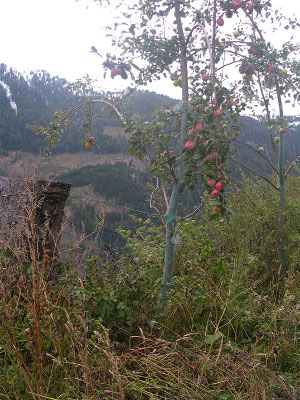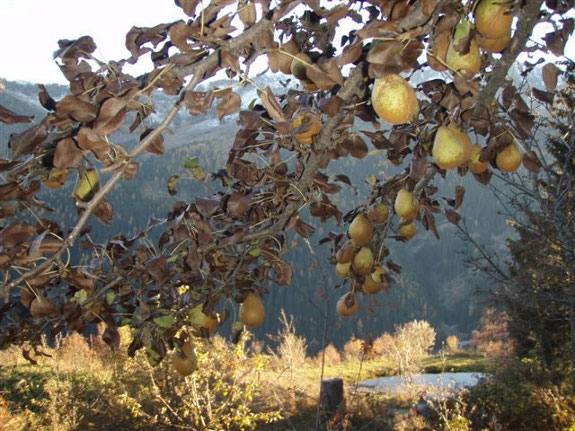
Do-nothing fruit
 After two or three years of soil
improvement, Sepp
Holzer is ready to start his (nearly) do-nothing orchards. With
over a hundred acres of farmland holding around 14,000 individual fruit
trees, Holzer clearly can't feed, prune, and manicure every inch of his
fruit plantation. Instead, he goes to the opposite extreme,
selecting for extremely hardy plants that can survive when planted into
plain soil and never pruned.
After two or three years of soil
improvement, Sepp
Holzer is ready to start his (nearly) do-nothing orchards. With
over a hundred acres of farmland holding around 14,000 individual fruit
trees, Holzer clearly can't feed, prune, and manicure every inch of his
fruit plantation. Instead, he goes to the opposite extreme,
selecting for extremely hardy plants that can survive when planted into
plain soil and never pruned.
In fact, Holzer doesn't even harvest most of his fruits. He sells
many of his heirloom pears to distillery owners who come and harvest
the fruits themselves, and most of the rest of the bounty falls to the
ground and feeds his livestock over the winter.
Holzer's first step when
expanding his orchard is to send pigs through to loosen the soil and
trample down the green manure plants. Next, he spreads pomace
that has fermented for about a month across the ground. (Pomace
is the skins and seeds left after making wine, oil, or --- in this case
--- cider.) The apple and pear seeds sprout and either grow or
die, with the seedlings best suited to the particular spot they've been
placed outcompeting the others. These seedlings will become
vigorous rootstocks, producing trees that grow taller and fruit later
than those on commercial rootstock, but also tend to live longer.
 A year or two after spreading
the pomace, Holzer comes through to transplant out trees that are too
close together --- these are grafted in his nursery and sold as one of
his sources of income. The best seedlings are left in place and
have heirloom apple and pear scionwood grafted on.
A year or two after spreading
the pomace, Holzer comes through to transplant out trees that are too
close together --- these are grafted in his nursery and sold as one of
his sources of income. The best seedlings are left in place and
have heirloom apple and pear scionwood grafted on.
Holzer doesn't prune at
all, not even to remove the watersprouts that pop up from the rootstock
(and which he believes protect the main trunk from nibbling
wildlife.) Rather than fertilizing the trees, he simply sends his
livestock through the area at intervals, meanwhile allowing the green
manure plants to continue to improve the soil around the trees' roots.
While I don't recommend
Holzer's do-nothing fruit production for the backyard hobbyist with
only a small growing area, his methods work very well for large
expanses of pasture. As you'll see in tomorrow's post, the fruit
trees provide so much food for his livestock that he barely has to feed
them at all.
| This post is part of our Sepp Holzer's Permaculture lunchtime series.
Read all of the entries: |
Want more in-depth information? Browse through our books.
Or explore more posts by date or by subject.
About us: Anna Hess and Mark Hamilton spent over a decade living self-sufficiently in the mountains of Virginia before moving north to start over from scratch in the foothills of Ohio. They've experimented with permaculture, no-till gardening, trailersteading, home-based microbusinesses and much more, writing about their adventures in both blogs and books.
Want to be notified when new comments are posted on this page? Click on the RSS button after you add a comment to subscribe to the comment feed, or simply check the box beside "email replies to me" while writing your comment.


Toland --- I was hoping you would weigh in. I thought maybe they spoke German in Austria, but I know so little about Europe... I used the feature on Google translate where you let it guess what language you're using.
I used the feature on Google translate where you let it guess what language you're using.
The words that didn't translate are probably the names of plants and things like that which aren't in a standard dictionary. (Too bad since those are often the things I want to know the most!)
I most wanted to know what the two roots were that I posted about yesterday, but when I followed the link and translated that heading today, it just vaguely talked about "two roots." Oh well!
Thanks for offering, though --- I'll keep that in mind the next time I peruse his site and get stuck.
The caption of the picture says "Enzianwurzeln" (hint; in German, nouns start with a capital letter).
Since I know that "wurzel" meens root. I looked up "Enzian" on the German wikipedia. Articles about plants on Wikipedia all have the proper scientific name ("Wissenschaftlicher Name" in German) on them. It is Gentiana, which is gentian in English. Not that difficult.
It seems that in Austria, roots of the yellow gentian (gentiana lutea) are used in making a schnapps (liquor) which is also called Enzian.
The roots of the yellow gentian are quite bitter. This bitterness is still recognizable in a 1:200000 solution in water of the active ingredient amarogentin (also found in swertia chirata).
Maybe a solution drawn from those roots could form a natural deterrant for deer when sprayed over/around your vegetables?
We've had no luck with taste based deer deterrents. You have to add them to your garden after every rain, and it rains here a lot. With the size of our garden, we'd probably spend several hours a week spraying deterrents on if we went that route.
But Holzer actually did mention a deer deterrent in his book. I can't remember the specifics, but it was supposed to be so foul-smelling that it kept away deer for months. (I don't know how much it rains there, though.)